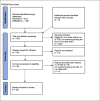Cerebral fractional tissue oxygen extraction (cFTOE) during immediate fetal-to-neonatal transition: a systematic qualitative review of the literature
- PMID: 38861023
- PMCID: PMC11322427
- DOI: 10.1007/s00431-024-05631-2
Cerebral fractional tissue oxygen extraction (cFTOE) during immediate fetal-to-neonatal transition: a systematic qualitative review of the literature
Abstract
Cerebral monitoring during immediate fetal-to-neonatal transition is of increasing interest. The cerebral fractional tissue oxygen extraction (cFTOE) is a useful parameter to gain insight in the balance between tissue oxygen delivery and consumption during this complex process. The aim of this study was to review the literature on cFTOE during the first 15 min immediately after birth. A systematic qualitative literature research was last performed on 23 November 2023 of PubMed and EMBASE with the following search terms: neonate, infant, newborn, transition, after birth, delivery room, NIRS, near-infrared spectroscopy, spectroscopy, cFTOE, cerebral fractional tissue oxygenation extraction, cerebral oxygenation, and fractional oxygen extraction. Additional published reports were identified through a manual search of references in retrieved articles and in review articles. The methodological quality of the included studies was assessed by predefined quality criteria. Only human studies with data of cFTOE in the first 15 min after birth were included. Accordingly, exclusion criteria were defined as no measurement of cFTOE or no measurement within the first 15 min after birth. Across all studies, a total of 3566 infants (2423 term, 1143 preterm infants) were analysed. Twenty-five studies were identified describing cFTOE within the first 15 min after birth. Four studies established reference ranges for cFTOE and another four studies focused on the effect of pre-/perinatal circumstances on cFTOE in the first 15 min after birth. Six studies investigated the course of cFTOE after transition in infants without complications. Eleven studies analysed different potentially influencing parameters on cFTOE during transition.
Conclusion: This systematic review provides a comprehensive insight on cFTOE during uncomplicated transition as well as the influence of perinatal circumstances, respiratory, haemodynamic, neurological, and laboratory parameters in preterm and term infants.
What is known: • The NIRS-measured cerebral fractional tissue oxygen extraction (cFTOE) is a useful parameter to estimate the balance between oxygen delivery and consumption. • During normal transition, the cFTOE decreases in the first minutes after birth and then remains at a stable plateau.
What is new: • The cFTOE is a promising parameter that gives additional information on cerebral oxygenation and perfusion in preterm and term infants. • Several hemodynamic, metabolic, respiratory, and perinatal factors are identified, influencing the oxygen extraction of the newborn's brain after birth.
Keywords: Cerebral fractional tissue oxygen extraction; FTOE; Near-infrared spectroscopy; Neonate; Transition; cFTOE.
© 2024. The Author(s).
Conflict of interest statement
The authors declare no competing interests.
Figures


References
-
- Madar J, Roehr CC, Ainsworth S, Ersdal H, Morley C, Rüdiger M, Skåre C, Szczapa T, Te Pas A, Trevisanuto D, Urlesberger B, Wilkinson D, Wyllie JP (2021) European Resuscitation Council guidelines 2021: newborn resuscitation and support of transition of infants at birth. Resuscitation 161:291–326. 10.1016/j.resuscitation.2021.02.014 10.1016/j.resuscitation.2021.02.014 - DOI - PubMed
-
- Aziz K, Lee HC, Escobedo MB, Hoover AV, Kamath-Rayne BD, Kapadia VS, Magid DJ, Niermeyer S, Schmölzer GM, Szyld E, Weiner GM, Wyckoff MH, Yamada NK, Zaichkin J (2020) Part 5: neonatal resuscitation: 2020 American Heart Association Guidelines for Cardiopulmonary Resuscitation and Emergency Cardiovascular Care. Circulation 142(16suppl2):S524–S550. 10.1161/CIR.0000000000000902 10.1161/CIR.0000000000000902 - DOI - PubMed
Publication types
MeSH terms
Substances
LinkOut - more resources
Full Text Sources

